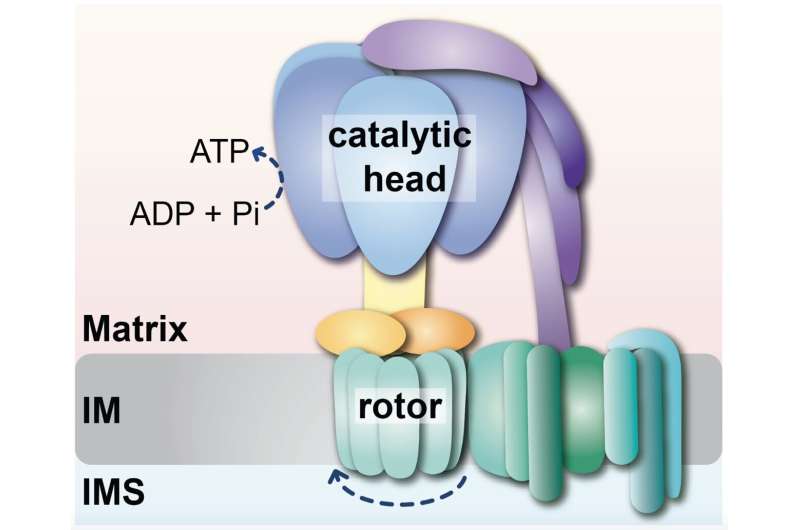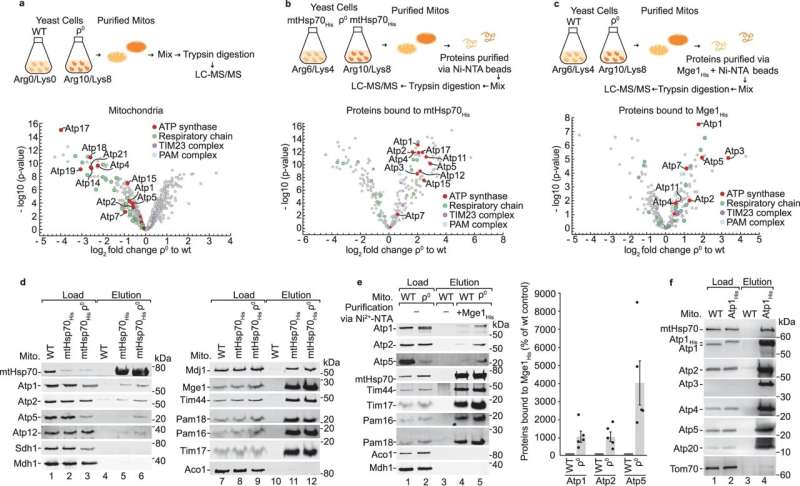This article has been reviewed according to Science X's editorial process and policies. Editors have highlighted the following attributes while ensuring the content's credibility:
fact-checked
peer-reviewed publication
proofread
Insights into the formation of ATP synthase: A new important function of the folding helper Hsp70

Scientists led by Prof. Thomas Becker, Director of the Institute of Biochemistry and Molecular Biology at the University Hospital Bonn (UKB), have gained new insights into the formation of ATP synthase, the turbine of the cells' power plants, the mitochondria.
A so-called "molecular chaperone", the protein Hsp70, carries out more functions in the maturation of proteins than previously thought. As the researchers have discovered, Hsp70 not only acts as a "folding helper" of proteins in mitochondria, but also promotes the assembly of ATP synthase. The new findings provide important findings for understanding how the ATP synthase is formed and is now published in the prestigious journal Nature Communications.
As it is well known, humans consist of many cells. If one considers each cell in the human body as a city with different buildings, then a mitochondrion is the power plant. Mitochondria produce the cellular energy currency ATP (adenosine triphosphate), which is essential for various processes in the cell. In particular, nerve and muscle tissues require a lot of energy for their functions. As usual in power plants, it needs workers in it, and in the case of mitochondria, these are proteins that are imported into the power plant from the cytosol.
The protein Hsp70 is involved in the import of many of these proteins into the interior of the mitochondria, the mitochondrial matrix, where it catalyzes the folding of the proteins so that they adopt the correct shape and do not clump together. Many proteins form together with partner proteins a functional unit called protein complexes. ATP synthase is one of such protein complexes, located in the inner membrane. ATP synthase produces the bulk of cellular energy and can therefore be considered as the turbine of cellular power plants.
"The ATP synthase protein complex consists of a spinning rotor driven by the back transport of protons into the mitochondrial matrix. This part is connected to the enzyme's catalytic head by a stalk, the molecular stator. The rotation of the rotor is transmitted to the catalytic head, causing it to produce ATP. How the stator and the catalytic head are formed and linked together was previously only partially understood," explains Prof. Thomas Becker.

The research group led by Prof. Thomas Becker at the UKB has now been able to gain new insights into this assembly process. The scientists have identified a central function of the protein Hsp70 in the formation of ATP synthase: Hsp70 is not only a folding helper, but also contributes to the assembly of this protein complex, according to the researchers.
Dr. Jiyao Song, a post-doctoral researcher in Prof. Becker's group, discovered that Hsp70 is involved with partner proteins in the assembly of the catalytic head. Together with Dr. Dominic Winter's team, she was able to show that subunits of the ATP synthase accumulate at the Hsp70 when the assembly of the ATP synthase is disturbed. Dr. Song further discovered that Hsp70 monitors the linkage of the catalytic head to the stator.
Thus, mitochondrial Hsp70 fulfills a dual function in the formation of ATP synthase: the assembly of the catalytic head and the controlled linkage of the head to the stator.
This research project within Collaborative Research Center 1218 provides new insights into the functional spectrum of Hsp70 and the formation of a central protein machinery for energy production in cells. "Defects in the formation of ATP synthase or mitochondrial Hsp70 lead to diseases, especially of the nervous system. Therefore, the new results can provide important contributions to the understanding of these defects," said Prof. Dr. Thomas Becker.
More information: Jiyao Song et al, The mitochondrial Hsp70 controls the assembly of the F1FO-ATP synthase, Nature Communications (2023). DOI: 10.1038/s41467-022-35720-5
Journal information: Nature Communications
Provided by University Hospital of Bonn



















